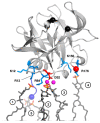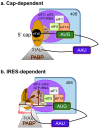Picornavirus 3C Proteins Intervene in Host Cell Processes through Proteolysis and Interactions with RNA
- PMID: 38140654
- PMCID: PMC10747604
- DOI: 10.3390/v15122413
Picornavirus 3C Proteins Intervene in Host Cell Processes through Proteolysis and Interactions with RNA
Abstract
The Picornaviridae family comprises a large group of non-enveloped viruses with enormous impact on human and animal health. The picornaviral genome contains one open reading frame encoding a single polyprotein that can be processed by viral proteases. The picornaviral 3C proteases share similar three-dimensional structures and play a significant role in the viral life cycle and virus-host interactions. Picornaviral 3C proteins also have conserved RNA-binding activities that contribute to the assembly of the viral RNA replication complex. The 3C protease is important for regulating the host cell response through the cleavage of critical host cell proteins, acting to selectively 'hijack' host factors involved in gene expression, promoting picornavirus replication, and inactivating key factors in innate immunity signaling pathways. The protease and RNA-binding activities of 3C are involved in viral polyprotein processing and the initiation of viral RNA synthesis. Most importantly, 3C modifies critical molecules in host organelles and maintains virus infection by subtly subverting host cell death through the blocking of transcription, translation, and nucleocytoplasmic trafficking to modulate cell physiology for viral replication. Here, we discuss the molecular mechanisms through which 3C mediates physiological processes involved in promoting virus infection, replication, and release.
Keywords: 3C protease; host cell defense; picornavirus; protein dynamics; protein structure; virus replication.
Conflict of interest statement
The authors declare no conflict of interest.
Figures






Similar articles
-
Picornavirus 3C - a protease ensuring virus replication and subverting host responses.J Cell Sci. 2021 Mar 10;134(5):jcs253237. doi: 10.1242/jcs.253237. J Cell Sci. 2021. PMID: 33692152 Review.
-
Roles of the Picornaviral 3C Proteinase in the Viral Life Cycle and Host Cells.Viruses. 2016 Mar 17;8(3):82. doi: 10.3390/v8030082. Viruses. 2016. PMID: 26999188 Free PMC article. Review.
-
Strawberry Mottle Virus (Family Secoviridae, Order Picornavirales) Encodes a Novel Glutamic Protease To Process the RNA2 Polyprotein at Two Cleavage Sites.J Virol. 2019 Feb 19;93(5):e01679-18. doi: 10.1128/JVI.01679-18. Print 2019 Mar 1. J Virol. 2019. PMID: 30541838 Free PMC article.
-
An efficient trans complementation system for in vivo replication of defective poliovirus mutants.J Virol. 2024 Jul 23;98(7):e0052324. doi: 10.1128/jvi.00523-24. Epub 2024 Jun 5. J Virol. 2024. PMID: 38837378 Free PMC article.
-
Picornaviruses and Apoptosis: Subversion of Cell Death.mBio. 2017 Sep 19;8(5):e01009-17. doi: 10.1128/mBio.01009-17. mBio. 2017. PMID: 28928208 Free PMC article. Review.
Cited by
-
Mapping mutational fitness effects across the coxsackievirus B3 proteome reveals distinct profiles of mutation tolerability.PLoS Biol. 2024 Jul 16;22(7):e3002709. doi: 10.1371/journal.pbio.3002709. eCollection 2024 Jul. PLoS Biol. 2024. PMID: 39012844 Free PMC article.
-
Assessment of optimized FRET substrates as universal corona- and picornavirus main protease substrates for screening assays.RSC Adv. 2024 Nov 5;14(48):35438-35446. doi: 10.1039/d4ra06573e. eCollection 2024 Nov 4. RSC Adv. 2024. PMID: 39502179 Free PMC article.
-
A Fluorescent Reporter Virus Toolkit for Interrogating Enterovirus Biology and Host Interactions.Viruses. 2025 May 30;17(6):796. doi: 10.3390/v17060796. Viruses. 2025. PMID: 40573387 Free PMC article.
-
Porcine Teschovirus 2 3Cpro Evades Host Antiviral Innate Immunity by Inhibiting the IFN-β Signaling Pathway.Microorganisms. 2025 May 26;13(6):1209. doi: 10.3390/microorganisms13061209. Microorganisms. 2025. PMID: 40572097 Free PMC article.
References
Publication types
MeSH terms
Substances
Grants and funding
LinkOut - more resources
Full Text Sources
Medical

